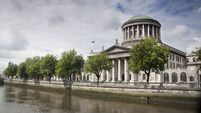The storms that shook Ireland a year on
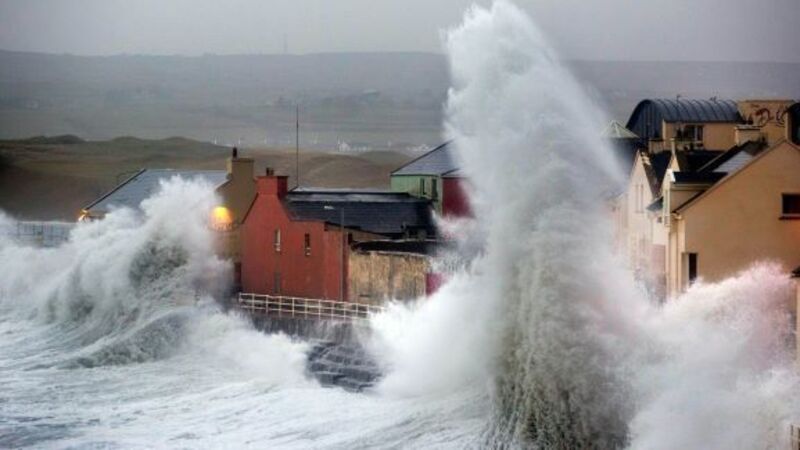
‘They did sterling work’
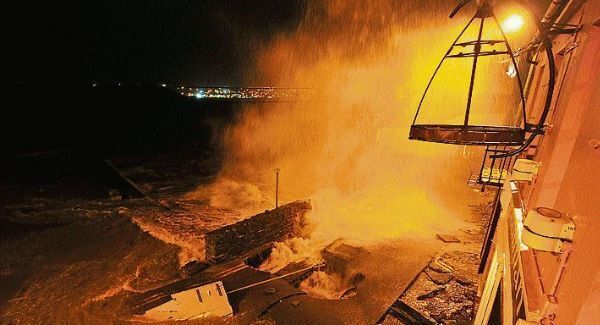
A publican who came within feet of losing his business during last year’s storms has praised the local authority’s response to the incident.
Pearse O’Sullivan, the chef patron of the Bulman in Summercove, Kinsale, Co Cork, says Cork County Council and contractor Barry Ryan and his team responded with speed and professionalism to the unprecedented damage outside his premises.
“The council and their contractor were great,” says Mr O’Sullivan. “They did sterling work on the road afterwards. It seems to be very, very solid. I think what they’ve done will do the job.
“You can only do what you can against nature. The sea generally will go where it wants to go.
“But I think what the council and the contractors have done here is provide a good defence.
“They poured concrete under the road and have certainly made it stronger than what it was.”
Mr O’Sullivan watched from the pub last February as the storm began to build strength in and around Kinsale harbour around 7.30pm and rage for almost two hours later. Huge waves pounded repeatedly into the small cove just a few feet from his pub’s front door.
He said he and his staff could see the storm surge eat away at the rock underneath the road and could see the road beginning to crumble over several minutes.
At around 9pm, they were worried that the tide was going to come into the pub, and evacuated customers upstairs and out the back.
The situation got so bad later that Mr O’Sullivan and his staff took it upon themselves to block the road because they knew its collapse was imminent.
Their prompt action probably saved lives.
It was only the morning after that the full extent of the damage became apparent.
The road had disappeared, and in its place was left a huge gaping crater — it was, in places, just two metres from the front door of the pub.
The sea walls had been battered to bits and the sewerage pump house in the adjoining car park was “blown apart”.
But council repair crews and contractors reacted immediately.
They were in a race against time because another massive storm was forecast to hit within a week.
They worked round the clock and within a week, the road had been fully repaired and was open to traffic.
“In fairness to them, they did move very quickly,” says Mr O’Sullivan.
“You can never say never, but I don’t think we’ll see that level of damage and destruction again. Last February’s storms were down to the combination of conditions — a high tide, and the wind coming from the perfect direction.
“But it was an old road which probably had shale underneath.
“They have now filled the underneath with concrete and hopefully it will be enough to withstand another big storm.”
Residents on alert as they await sea barrier
Most houses in Foynes have one item of essential reading for reference purposes: The tides timetable booklet for the Shannon Estuary.
Residents go on alert if spring tides coincide with high winds or storms.
Last January, a spring tide and a storm led to most of the village being submerged. Worst affected were houses and business premises on the port side of Main St. The force of the tide breached a wall, adjacent to the port, which protects the village, and a surge of water, up to four feet high, swept through. Within minutes, homes and business premises were deluged.
One resident, Josephine Finucane, aged 98, was asleep downstairs in her home on Main St. Garda Sergeant Eugene McSweeney checked on her at around 7am.
On being awoken by Sgt McSweeney, knocking on her bedroom window, Ms Finucane discovered she was trapped in a flooded room.
Sgt McSweeney raised the alarm. Emergency services rescued her, and she was taken to St Ita’s Hospital in Newcastle West, where she was cared for over a period of months.
Ms Finucane is now home, but, like all her neighbours, she lives in fear of another big flood.
Her son, Michael Finucane, a former Fine Gael TD, says his mother had a very lucky escape.
“She uses an electric bed. However, the electricity supply was tripped by the flood waters,” he says. “Had this not happened it could have been far more serious. Thanks to the great work of the emergency services she was rescued from her flooded home and got great care in Newcastle West.”
Meetings have taken place between the Shannon Foynes Port Company, Limerick City and County Council, the Office of Public Works, and Foynes Community Council about rebuilding a protective wall or embankment to give better protection. It is estimated this work will cost over €400,000.
Mr Finucane says: “In my lifetime in Foynes, there have been at least four big floods. I remember as a young lad coming down the stairs one morning and being met by floodwaters half way up the stairs. As well as the trauma of the flood last year, residents and business people are in constant fear of another big Spring tide combined with a storm. For that reason, most people in Foynes carry a tide timetable”.
They are now on constant alert and will remain so until a new protection barrier is put in place between the rear of the main street and the main pier at the port.
Minister of state Simon Harris has visited Foynes for meetings with the various agencies and local groups.
: “The minister is aware of the urgency of the situation and the meetings with him have been very constructive,” says Mr Finucane.
Top: Waves crash over O’Looney’s premises in Lahinch, Co Clare. Above: In calmer times. Pictures: Pat Flynn and Eamon Ward
Lahinch recovers after its deluge
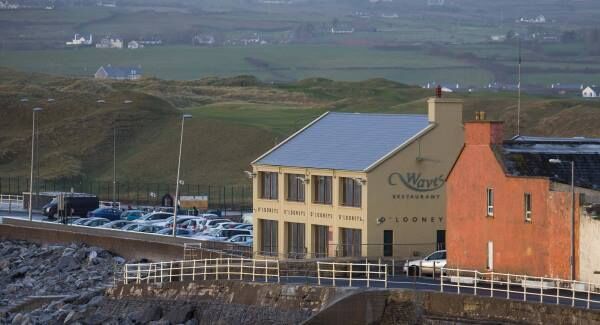
Surveying Lahinch 12 months after the seaside resort was battered by last January’s storms, local businessman Antoin O’Looney observed: “Lahinch has come out of it quite well.”
Before first light on January 3 last year, he made valiant efforts to minimise damage to his public house O’Looney’s which sits on Lahinch’s promenade.
Monster waves topped the roof of his pub- restaurant and shut all parts of it down until April/May of this year.
“I never saw anything like it,” Mr O’Looney remembers.
However, he is now upbeat about Lahinch’s recovery from the storm damage. “It was mainly businesses on the seafront that took a battering, but we had a very good year between O’Looney’s and Moy House,” says Mr O’Looney.
“Listen, no one died or no one was badly hurt.”
Damage across Co Clare resulted in Clare County Council slapping a €38m bill in to Government to repair the damage done, that included €13m in coastal protection works.
However, the vast majority of works remain to be done, prompting the council’s senior engineer, Tom Tiernan, to reassure councillors recently that there is no impasse with the Office of Public Works in relation to a spend of €12.1m towards strengthening works.
One area in need of permanent strengthening works is Cloughaninchy, further down the Clare coast near Quilty.
Michael Neenan, chairman of the Cloughaninchy Action Group, said: “Last January, this place was a disaster zone and the community here will be wiped out if the protection works were not put in place.”
Mr Neenan said that homes at Cloughaninchy are about only 100m from high tide.
He said: “Until the permanent works are put in place, we will be on tenterhooks about the storms that will come this winter.
“What happened to the householders here was very frightening and terrible.”
However, Mr Neenan said that the OPW has sanctioned €200,000 spending on a feasibility study to determine what works can be put in place.
Mr Neenan said: “We are very happy with the progress.
“The minister for the OPW, Simon Harris, has told us that he is committed to finding a solution for us here. The temporary works are in place and 12 months on we are quite positive about the way things have gone.”
Lahinch hotelier and former president of the Irish Hotels’ Federation Michael Vaughan said that the January storms had “given rise to a new genre of tourist — that is the storm-watcher”.
He said: “We have had thousands of them in Lahinch this past year and they buy their coffees and snacks here and they have provided a boost to the area.
“I think the village has responded very well to the storm and it has shown a huge sense of community. I don’t think we suffered adversely from the storm.”
One of the most recognisable images of the storm was a half- submerged surf van at Lahinch, belonging to Ben’s Surf Clinic.
Ben Bennett said yesterday: “The season here was slow to start because people thought that Lahinch was so badly damaged, but because the weather has been so mild during the year, we have had a very long season and a really good one.”
Mr Bennett said that much work needs to be done, with Lahinch still bearing the scars of the storm.
He said: “The council did brilliant work in getting the prom open again, but the likes of capping on walls still needs to be replaced.”
Mr O’Looney added: “The council can’t barricade the entire coastline.
“It doesn’t have a bottomless pit of money and it will have to make strategic decisions on areas to protect.”
Veronica was a prisoner in her own home
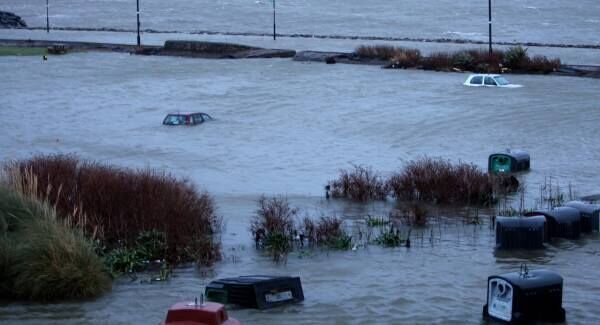
Early on the morning of January 3, 2014, Veronica Lydon woke up to a nightmare. Only recently has she finally began to breathe easily again. It had been a terrible night, but nothing could have prepared her for what awaited outside.
The roadway from her home to the main road, a stretch of almost a quarter of a mile, had disappeared. “It was completely washed away by the big storm and the sea and all that was left was a big drain, right out to the road. The drain was big enough for a child to fall right into it,” Veronica says.
With two small children and no means of making it to nearby Carna village in Connemara, Veronica became like a prisoner in her own home for the next six weeks. Her only means of exit was through a series of fields, an almost impossible journey with her two youngsters.
“Your first thought in the morning should never be: ‘Will I make it up the hill to the road today?’ Yet that was what I had to live with, trying to get over rough terrain just to make it to the main road. I had no visitors because nobody could get to me,” she says.
A massage therapist, Veronica had grown up in south Connemara and knew the area intimately. It had crossed her mind when applying for planning permission that she was living close to the seashore, but never in living memory had the sea threatened the location where she set up home.
When she sought help from Galway County Council and the assistance of local politicians, she found sympathy for her plight from every quarter. But nothing could be done.
Her road was deemed private property, even though it was along the seashore where the sea had come from to bring about her nightmare. “I even wrote to the President and to the Taoiseach — anybody I could find.”
Locals rallied and she was given access to a neighbour’s road. However, after months of stress and pleading, she finally set about trying to restore her road herself. She got a credit union loan and a local contractor did “a very fair” deal with her to rebuild the road. It has now finally opened. “The loan will be following me around for the next five years, but at least it is done and we can get on with life,” she says.
“I cried bitter tears that morning when I saw the storm damage, but I came to realise that not a hair on my kids’ heads had been touched. Other people had their houses destroyed.”
Across Connemara, the storm damage was estimated at up to €18m. Roads, walls, piers, graveyards, and coastal defences were all torn apart by the gale-force winds and flooding.
Almost a year later, Galway County Council spokesman Liam Gavin says 90% of the work has been finished. “There was damage all the way along the coast from Spiddal to Clifden and Ballyconneely and out into the offshore islands,” he says.
“One of the jobs we had to do was to recover three to four cars from the pier at Cleggan. They had been washed into the sea overnight and were an obvious threat to the environment.
“We have repaired 14 of the 15 piers that were damaged and carried out remedial work at a number of graveyards, where graves were in danger of slipping into the sea. Remains had been exposed in some place.”
Further work remains to be done, mainly on the Aran Islands and Inishbofin, as well as in south Galway.
The paths on the Prom in Salthill, which had flooded, have been repaired, while the popular 600m walkway from Blackrock to Birdoo, along by Galway golf course, has been completely restored. Moveable floodgates are being put in place in other parts of Salthill.
City council spokesman Gary McMahon said it had been a long year of repairs and planning. “It has taken months and an awful lot of blood, sweat and tears. But we are now very hopeful that the measures we have put in place will see to it that we don’t have a repeat of what happened just a year ago,” he said.
Top: Rossbeigh Beach last month, protected by large boulders. Above: Locals assess the rock-strewn road in January of last year. Pictures: Don MacMonagle and Valerie O’Sullivan
Just €2.7m received in funds
Few places took such a ferocious battering from the early 2014 storms as Rossbeigh Beach.
Shocked locals awoke on the morning of Friday, January 3, to find a large stretch of the road leading to the facility torn up, with chunks of tarmac scattered all around the place.
A massive tidal surge and mountainous waves had also lifted large rocks and stones from the beach onto a 1km stretch of the road, while a children’s playground had also been destroyed.
Elderly locals said they could not remember a storm or destruction like it and people were not exaggerating when they described the scene as being “like a tsunami”.
However, that scene has since been transformed following a new, protection scheme by Kerry County Council along an 800m section of the beach — though it looks quite different from pre-storm Rossbeigh.
Huge boulders, some weighing five tonnes, have been brought in to provide a 10m deep barrier between road and sea, while new, angled paths have been provided to enable pedestrian access to the beach. The work is called rock armour revetment.
The council had sought €11.5m from the government fund for repairing coastal damage and received just € 2.7m, of which around €1.5m was spent in Rossbeigh.
“The damage at Rossbeigh was by far the worst along the Kerry coastline and we feel we’ve made the best possible use of the resources available to us. The work has been welcomed in the area,’’ said Eamon Scanlan, senior executive engineer with the council.
Local Independent councillor Michael Cahill said he was particularly pleased with the work at Rossbeigh and nearby Kells, where a car park was washed away.
“I think the work has been done very well and it will stand up to future storms and whatever the elements throw at it,” he said. “It’s the first time in 40 years that significant money was spent in Rossbeigh.
“If this level of rock armour doesn’t protect the beach, nothing will. However, I’d be concerned about what will happen to the other parts of the beach that do not have this level protection. We need a lot more protection work to be done.’’
He also highlighted another continuing problem at Rossbeigh — erosion in the dunes area is worsening, leaving hundreds of acres of low-lying land and homes, which had previously been protected by the dunes, exposed to flooding.
Mr Cahill said he would be especially concerned about consequences for the Cromane area.
“The gap that the waves have made through the dunes is widening all the time. It’s a very serious problem and difficult to tackle,’’ he said.
On St Stephen’s night, last year, about 20 acres of dunes — an estimated 1m tonnes of sand — disappeared in a storm and the erosion is continuing.
The wooden skeleton of an old schooner, The Sunbeam, a feature on the beach at Rossbeigh since 1903, is also subject to damage from the sea.
The wreck had been embedded on the beach prior to last year’s storms, but was lifted several hundred metres towards the dunes by the power of the waves.
A decision on what to do with the legally-protected wreck is awaited from state agencies.
The council, meanwhile, has also reinstated the Rossbeigh children’s playground and has carried out repair work at Kinard and Kilshannig, in the Dingle Peninsula, where further work is required, at Waterville and Ballyheigue.










